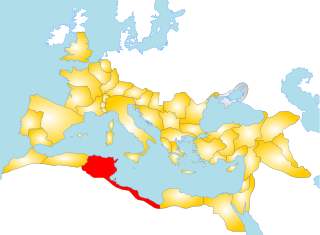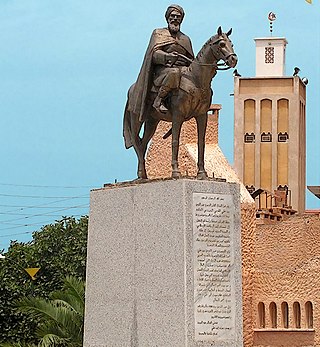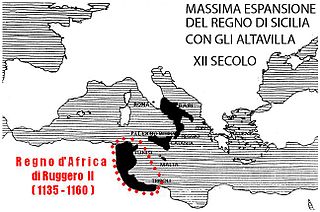Related Research Articles

The present day Republic of Tunisia, al-Jumhuriyyah at-Tunisiyyah, is situated in Northern Africa. Geographically situated between Libya to the east, Algeria to the west and the Mediterranean Sea to the north. Tunis is the capital and the largest city ; it is near the ancient site of the city of Carthage.

Ibn Khaldun was an Arab sociologist, philosopher, and historian widely acknowledged to be one of the greatest social scientists of the Middle Ages, and considered by many to be the father of historiography, sociology, economics, and demography studies.

Medieval Muslim Algeria was a period of Muslim dominance in Algeria during the Middle Ages, spanning the millennium from the 7th century to the 17th century. The new faith, in its various forms, would penetrate nearly all segments of society, bringing with it armies, learned men, and fervent mystics; in large part, it would replace tribal practices and loyalties with new social norms and political idioms.

Al-Andalus was the Muslim-ruled area of the Iberian Peninsula. The term is used by modern historians for the former Islamic states in modern Spain and Portugal. At its greatest geographical extent, it occupied most of the peninsula and a part of present-day southern France, Septimania. For nearly 100 years, from the 9th century to the 10th, al-Andalus extended its presence from Fraxinetum into the Alps with a series of organized raids. The name describes the different Muslim states that controlled these territories at various times between 711 and 1492. These boundaries changed constantly as the Christian Reconquista progressed, eventually shrinking to the south and finally to the Emirate of Granada.

Ifriqiya, also known as al-Maghrib al-Adna, was a medieval historical region comprising today's Tunisia and eastern Algeria, and Tripolitania. It included all of what had previously been the Byzantine province of Africa Proconsularis and extended beyond it, but did not include the Mauretanias.

The Hammadid dynasty was a branch of the Sanhaja Berber dynasty that ruled an area roughly corresponding to north-eastern modern Algeria between 1008 and 1152. The state reached its peak under Nasir ibn Alnas during which it was briefly the most important state in Northwest Africa. Its realm was conquered by the Almohad Caliphate.

The Banu Hilal was a confederation of Arabian tribes from the Hejaz and Najd regions of the Arabian Peninsula that emigrated to North Africa in the 11th century. Masters of the vast plateaux of the Najd, they enjoyed a somewhat infamous reputation, possibly owing to their relatively late conversion to Islam and accounts of their campaigns in the borderlands between Iraq and Syria. When the Fatimid Caliphate became masters of Egypt and the founders of Cairo in 969, they hastened to confine the unruly Bedouin in the south before sending them to Central North Africa and then to Morocco.

Abd al Mu'min was a prominent member of the Almohad movement. Although the Almohad movement itself was founded by Ibn Tumart, Abd al-Mu’min was the founder of the Almohad dynasty and creator of the dynasty's empire. As a leader of the Almohad movement he became the first Caliph of the Almohad Empire in 1133, after the death in 1130 of the movement's founder, Ibn Tumart, and ruled until his death in 1163. Abd al-Mu'min put his predecessor's doctrine of Almohadism into practice, defeated the Almoravids in present-day Morocco, and extended his rule across Al-Andalus and as far as Tunis in Ifriqiya, thus bringing the Maghreb in North Africa and Al-Andalus in Europe under one creed and one government.

The Hafsids were a Sunni Muslim dynasty of Berber descent who ruled Ifriqiya from 1229 to 1574.

The Marinid Sultanate was a Berber Muslim empire from the mid-13th to the 15th century which controlled present-day Morocco and, intermittently, other parts of North Africa and of the southern Iberian Peninsula (Spain) around Gibraltar. It was named after the Banu Marin, a Zenata Berber tribe. The sultanate was ruled by the Marinid dynasty, founded by Abd al-Haqq I.

Abu Abd Allah Amghar Ibn Tumart was a Muslim Berber religious scholar, teacher and political leader, from the Sous in southern present-day Morocco. He founded and served as the spiritual and first military leader of the Almohad movement, a puritanical reform movement launched among the Masmuda Berbers of the Atlas Mountains. Ibn Tumart launched an open revolt against the ruling Almoravids during the 1120s. After his death his followers, the Almohads, went on to conquer much of North Africa and part of Spain.

Sijilmasa was a medieval Moroccan city and trade entrepôt at the northern edge of the Sahara in Morocco. The ruins of the town extend for five miles along the River Ziz in the Tafilalt oasis near the town of Rissani. The town's history was marked by several successive invasions by Berber dynasties. Up until the 14th century, as the northern terminus for the western trans-Sahara trade route, it was one of the most important trade centres in the Maghreb during the Middle Ages.

Qal'at Bani Hammad, also known as Qal'a Bani Hammad or Qal'at of the Beni Hammad, is a fortified palatine city in Algeria. Now in ruins, in the 11th century, it served as the first capital of the Hammadid dynasty. It is in the Hodna Mountains northeast of M'Sila, at an elevation of 1,418 metres (4,652 ft), and receives abundant water from the surrounding mountains. The site is near the town of Maadid, about 225 kilometres (140 mi) southeast of Algiers, in the Maghreb.

The medieval era of Tunisia began with what would eventually return Ifriqiya to local Berber rule. The Shia Islamic Fatimid Caliphate departed to their newly conquered territories in Egypt leaving the Zirid dynasty to govern in their stead. The Zirids would eventually break all ties to the Fatimids and formally embrace Sunni Islamic doctrines.

Almohad doctrine or Almohadism was the ideology underpinning the Almohad movement, founded by Ibn Tumart, which created the Almohad Empire during the 12th to 13th centuries. Fundamental to Almohadism was Ibn Tumart's radical interpretation of tawḥid—"unity" or "oneness"—from which the Almohads get their name: al-muwaḥḥidūn (المُوَحِّدون).

The Kingdom of Africa was an extension of the frontier zone of the Siculo-Norman state in the former Roman province of Africa, corresponding to Tunisia and parts of Algeria and Libya today. The main primary sources for the kingdom are Arabic (Muslim); the Latin (Christian) sources are scanter.
Lubābu l-Muhassal fi Usul al-Din is a book on Islamic theology by the scholar Ibn Khaldūn, written in around 1351. The book was Khaldūn's first work, written when he was 19 or 20 years old. Lubābu l-Muhassal is a commentary on Muhassal Afkar al-Mutaqaddimin wa al-Muta'akhkhirin, a work on theology by Fakhr al-Din al-Razi. Khaldūn wrote the book under the supervision of his teacher al-Ābilī while living in Tunis, Tunisia.
The Battle of al-Buhayra was a battle between the Almoravid and the Almohad armies in May 1130 CE just outside Marrakesh, Morocco.
The Zirid conquest of Málaga occurred in 1056 between the Zirid Taifa of Granada and the Hammudid Taifa of Málaga.
Abū Ḥafṣ ʿUmar b. Yaḥyā al-Hintātī, chief of the Hintata, was a close companion of Ibn Tumart and a shaper of the Almohad Empire greatly responsible for the unification of the Almohad corps. His grandson Abū Zakariyyāʾ Yahyā b. ʿAbd al-Waḥīd founded the Hafsid dynasty in Ifriqiya. He lived a long life and helped maintain ties between the Almohad movement's early revolutionary doctrine and its later dynastic period established by ʿAbd al-Muʾmin.
References
- ↑ "The rise of the Almohads: Islam, identity and belief in north Africa. - History On-line". www.history.ac.uk.
- ↑ "Allen Fromherz - History". history.gsu.edu. Archived from the original on 2018-08-26. Retrieved 2018-10-25.
- 1 2 "Qatar - Georgetown University Press". press.georgetown.edu. Archived from the original on 2018-11-06. Retrieved 2018-10-25.
- ↑ "Edinburgh University Press Books".
- ↑ "Edinburgh University Press Books". edinburghuniversitypress.com. Retrieved 2022-09-01.
- ↑ "Administration – AIMS". aimsnorthafrica.org. Archived from the original on 2018-08-18. Retrieved 2018-10-25.
- ↑ Dhabi, NYU Abu. "Past Fellows". New York University Abu Dhabi.
- ↑ "CAORC - Governance". Council of American Overseas Research Centers.
- ↑ "Viviana Cortes, Allen Fromherz Named Fulbright Scholars - Provost's Office". Office of the Provost. 2022-06-16. Retrieved 2022-09-01.
- ↑ "I.B.Tauris Publishers".
- ↑ "Allen James Fromherz". Edinburgh University Press Books.
- ↑ Fromherz, Allen James (2016). "Medieval North Africa, Latin Europe and the Mediterranean in the Second Axial Age". The Near West: Medieval North Africa, Latin Europe and the Mediterranean in the Second Axial Age. Edinburgh University Press. ISBN 9780748642946. JSTOR 10.3366/j.ctt1bh2j9j.
- ↑ "Qatar | Georgetown University Press".
- ↑ The Gulf in World History: Arabia at the Global Crossroads. Oxford University Press. 1 October 2018. ISBN 9781474430654.
- ↑ Fromherz, Allen James (2021). "Introduction and Summary: The Hafsids and the Axial Western Mediterranean". The Journal of North African Studies. 26 (4): 593–596. doi: 10.1080/13629387.2020.1763101 . S2CID 219459632.
- ↑ Knowledge, Authority and Change in Islamic Societies: Studies in Honor of Dale F. Eickelman. Brill. 2021-01-21. ISBN 978-90-04-44334-1.
- ↑ "Edinburgh University Press Books". edinburghuniversitypress.com. Retrieved 2022-09-01.